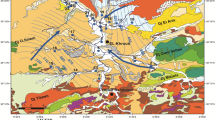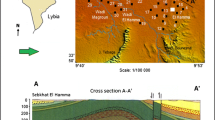Abstract
The paper presents fuzzy groundwater classification rule base derivation from groundwater quality variation maps, which are based on any three ions. These maps are obtained by geostatistical (Kriging) methodology and the results are presented in the form of equal ion concentration lines (contours). They help to visualize mutual relationships between three ions with linguistic interpretations. For this purpose each ion is separated into three linguistic categories, as ‘low,’ ‘medium’ and ‘high,’ which are characterized numerically by membership functions (MFs). MFs are transformers of linguistic expressions into numbers and vice versa. Accordingly, the linguistic fuzzy rules are presented for total dissolved solids’ (TDS) occurrence based on two different ions. In general, it is possible to deduce fuzzy logical rules relating any ion to the other two ions.
Similar content being viewed by others
References
Altunkaynak A, Özger M, Şen Z (2003) Triple diagram model of level fluctuations in Lake Van. Turkey Hydrol Earth Syst Sci 7(2):235–244
Davis JC (1986) Statistics and data analysis in geology. Wiley, New York, p 646
Davis SN, DeWiest RJM (1966) Hydrogeology. Wiley, New York
Fetter CW Jr (1980) Applied hydrogeology. Charles E. Merrill, Columbus
Freeze RA, Cherry JA (1979) Groundwater. Prentice-Hall, Englewood Cliffs, p 604
Hudson RO, Golding DL (1997) Controls on groundwater chemistry in subalpine catchments in the southern interior of British Columbia. J Hydrol 201:1–20
Journel A, Huijbregts A (1978) Mining geostatistics. Academic Press, London
Kimblin RT (1995) The chemistry and origin of groundwater in Triassic sandstone and Quaternary deposits, northwest England and some UK comparisons. J Hydrol 172:293–308
Matheron G (1963) Principles of geostatistics. Econ Geol 58:1246–1266
Matheron G (1965) Les variables regionalisees et leur estimation. Masson, Paris, p 306
Mayo AL, Loucks MD (1995) Solute and isotopic geochemistry and groundwater flow in the central Wasatch range, Utah. J Hydrol 172:31–59
Miller JA (1991) Summary of the hydrology of the southeastern coastal plain aquifer system in Mississippi, Alabama, Georgia and South Carolina. US Geological Survey Professional Paper 1410-A, pp 33–36
Piper AM (1944) A graphic procedure in the geochemical interpretation of water analysis. Trans Am Geophys Union 25:914–923
Ross JT (1995) Fuzzy logic with engineering applications. McGraw-Hill, New York, 593 pp
Şen Z, Saud A, Altunkaynak A, Özger M (2005) Increasing water supply by mixing of fresh and saline ground waters. J Am Water Resour Assoc 39(5):1209–1215
Şen Z (2009a) Spatial modeling principles in earth sciences. Springer, 320 pp, in print
Şen Z (2009b) Fuzzy logic and hydrologic modeling. Taylor and Francis, 340 pp, in print
Zadeh LA (1965) Fuzzy sets. Inf Control 8, 338–353
Zadeh LA (1999) From computing with numbers to computing with words—from manipulation of measurements to manipulation of perceptions. IEEE Trans Circuits Syst 45(1):105–119
Zadeh LA (2001) A new direction in AI towards a computational theory of perceptions. Am Assoc Artif Intell Mag, Spring 2001, 73–84
Author information
Authors and Affiliations
Corresponding author
Rights and permissions
About this article
Cite this article
Şen, Z. Fuzzy Groundwater Classification Rule Derivation from Quality Maps. Water Expo. Health 1, 115–122 (2009). https://doi.org/10.1007/s12403-009-0011-x
Received:
Revised:
Accepted:
Published:
Issue Date:
DOI: https://doi.org/10.1007/s12403-009-0011-x




